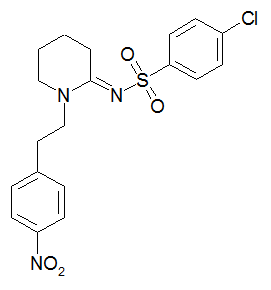1-(4-Nitrophenylethyl)piperidylidene-2-(4-chlorophenyl)sulfonamide
 | |
| Legal status | |
|---|---|
| Legal status |
|
| Identifiers | |
| |
| PubChem CID | |
| E number | {{#property:P628}} |
| ECHA InfoCard | {{#property:P2566}}Lua error in Module:EditAtWikidata at line 36: attempt to index field 'wikibase' (a nil value). |
| Chemical and physical data | |
| Formula | C19H20ClN3O4S |
| Molar mass | 421.91 g/mol |
| 3D model (JSmol) | |
| Melting point | 157 to 158 °C (Expression error: Unrecognized word "to". °F) |
| |
Editor-In-Chief: C. Michael Gibson, M.S., M.D. [1]
Overview
1-(4-Nitrophenylethyl)piperidylidene-2-(4-chlorophenyl)sulfonamide (W-18) is a potent μ-opioid agonist with a distinctive chemical structure which is not closely related to other established families of opioid drugs. It was invented by the chemists Edward Knaus, Brent Warran and Theodore Ondrus in 1981.[1]
This compound was found to be around 10,000x more potent than morphine in animal studies, however due to its structural differences from other opioid drugs it would be difficult to represent as being "substantially similar in chemical structure" to any controlled drugs. This makes it likely that it would be legal throughout the world.
It has never been used in humans, but would be expected to produce effects similar to those of other potent opioid agonists, including strong analgesia, sedation, euphoria, constipation, itching and respiratory depression which could be harmful or fatal. Tolerance and dependence would be expected to develop rapidly based on the potency of the drug, as it is of a similar strength to carfentanil and so would most likely cause pronounced tachyphylaxis following repeated dosing, as is seen with the potent fentanyl analogues.
References
- Pages with script errors
- Pages with non-numeric formatnum arguments
- Drugs with non-standard legal status
- E number from Wikidata
- ECHA InfoCard ID from Wikidata
- Chemical articles with unknown parameter in Infobox drug
- Chemical articles without CAS registry number
- Articles without EBI source
- Chemical pages without ChemSpiderID
- Chemical pages without DrugBank identifier
- Articles without KEGG source
- Articles without InChI source
- Articles without UNII source
- Drugs missing an ATC code
- Articles containing unverified chemical infoboxes
- Opioids